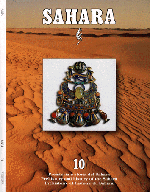| Contents
Abstracts |
Abstracts of Sahara volume 10
(published May 1999)
|
 |
Frank W. Eddy and Fred Wendorf
Prehistoric pastoral nomads in the Sinai
ABSTRACT
The Timnia tradition of the southern Levant is one of the earliest (7000-3000 BP) nomadic pastoral cultures presently described. This prehistoric example is amplified, based on archaeological investigations conducted in 1996 by the Combined Prehistoric Expedition (CPE) involving field work in the upper Wadi Girafi Basin, east central Sinai, Egypt. A regional environmental analysis shows that nomadic tent pastoralists herding goats and sheep as well as cattle were a response to desert living during arid times. Such an adaption in indicated twice in the settlement data. The first time was during the Chalcolithic (6500-4800 BP) and again during the Middle Bronze Age during a second dry interval (3800-3300 BP). In contrast, semi-nomadic pastoralists were a response to the wetter climate (4800-3800 BP) which appeared during the Early Bronze Age. Thus the Chalcolithic/Bronze Age archaeology shows a pattern in which the fully nomadic community alternated with semi-nomadic pastoralism according to the intensity of rainfall and availability of forage. Thus these two different prehistoric settlement patterns were adaptive responses to changing climatic conditions.
|
|
Top

|
Robert Vernet
Le littoral du Sahara atlantique mauritanien au Néolithique
ABSTRACT
Le littoral atlantique du Sahara, aujourd’hui très aride, a été, à plusieurs reprises pendant le préhistoire, et en particulier au Néolithique, une région très riche. Lorsque les conditions climatiques planétaires sont favorables, la côte atlantique du Sahara n’est plus ce désert surtout sableux, bordant un océan poissonneux, que nous connaissons aujourd’hui. Elle est au contraire une juxtaposition de milieux sahéliens variés très propices à la vie humaine. C’est au Néolithique et au début de l’Histoire que le peuplement de la région a été le plus dense. Après 7000 B.P., outre des chasseurs, des pêcheurs s’installent. À partir de 4000 B.P. l’élevage est introduit et devient rapidement une des principales activités. Après 3000 B.P. au nord de Nouakchott et après 2000 dans l’ensemble de la région, les conditions climatiques impliquent de profonds changements: glissement vers le sud des anciens groupes humains soucieux de maintenir leur mode de vie et apparition des nomades sahariens. |
|
Top
|
Christian Dupuy
Réflexion sur l’identité des guerriers représentés dans les gravures rupestres de l’Adrar des Iforas et de l’Aïr
ABSTRACT
Le nombre des représentations gravées de guerriers relevées à ce jour dans les massifs de l’Adrar des Iforas et de l’Aïr approche le millier. L’analyse de leur contexte de réalisation, de leurs vêtements, parures, coiffures et armes alliée à l’étude des superpositions apparaissant sur certaines gravures, permettent la reconnaissance de deux phases distinctes dans cet art rupestre du Sahara méridional. La phase la plus ancienne participe d’une économie pastorale fondée sur l’élevage des bovins à une époque où le métal est connu dans le sud du Sahara et le port de la lance préféré à ceux plus anciens de l’arc et d’objets coudés. Une population possédant des chars et des chevaux occupe alors le Sahara central et entretient des relations avec ces éleveurs de bovins à tradition de gravure rupestre de l’Aïr et de l’Adrar des Iforas. La pratique de nomadisme pastoral de la part de ces derniers fournit une explication à la vaste répartition géographique de leurs oeuvres rupestres.
|
|
Top
|
Farouk El-Baz
Aeolian deposits and palaeo-rivers of the eastern Sahara.
Significance to archaeology and groundwater exploration
ABSTRACT
Aeolian action in the eastern Sahara created distinctly linear patterns that trend southward from the Mediterranean seashore. Wind directions that were responsible for these patterns must have prevailed during at least the past 5,000 years. In most cases, sand dunes emanated from topographic depressions prior to the initiation of the aeolian activities. Radar images from space proved the existence of sand-buried and structurally controlled courses of palaeo-channels that terminated at the same topographic depressions. Prehistoric human habitation existed mostly near the edges of palaeo-lakes that filled the depressions; additional sites might also be distributed along the banks of the palaeo-channels. This geologic setting suggests that the sand must have originated from the “Nubian Sandstone” exposures in the southern part of the eastern Sahara. The sand was carried northward in river courses during wet climate episodes. During dry climates, particularly starting 5,000 years ago, the sand was mobilized by wind to form today’s southward-moving dunes.
|
|
Top

|
Jean-Loïc Le Quellec
Reconnaissance à Awenât
Les figurations rupestres de Karkûr Drîs et Karkûr Ibrahîm (Libye)
ABSTRACT
Une reconnaissance à Awenât a permis de visiter quelques sites à peintures rupestres de la partie occidentale du massif (Karkur Dris et Karkur Ibrahim). Le bestiaire figuré, les données culturelles et le cadre climatique général permettent de supposer que l’activité des peintres locaux n’a pu se déployer avant 4000 BP.
|
|
Top
|
Steven E. Sidebotham and Willemina Z. Wendrich
Berenike: Archaeological fieldwork at a Ptolemaic-Roman port on the Red Sea coast of Egypt (1994-1998)
ABSTRACT
Survey and excavation of the Ptolemaic-Roman (third century B.C.-sixth century A.D.) emporium of Berenike on the Red Sea coast of Egypt has revealed extensive commercial contacts locally, regionally and ‘internationally’ involving a variety of ethnic groups whose presence on the site is attested by epigraphic, floral, faunal and artifactual remains. An elaborate road network connected Berenike to emporia on the Nile and to other settlements in the Eastern Desert. Excavations through 1998 identified groups from around the Mediterranean, the Middle East, the Nile, Nubia and South Asia residing at Berenike. Trade through Berenike with other areas of the Red Sea-Indian Ocean was most active in the early Roman period (late first century B.C.-first century A.D.) with a second peak beginning in the second half of the fourth century A.D. on. Sometime before the middle of the sixth century A.D., probably due in part to the silting up of the harbour, Berenike was abandoned.
|
|
Top
|
Alessandra Nibbi
Notes on the so-called Eastern Libyans, Ancient Egypt and the horse and chariot
ABSTRACT
We constantly find references to the Libyans in the ancient records but it is difficult to be precise about their identity. According to the evidence from the Egyptian documents, there were people settled west of the Nile, within reach of the water of the inundation each year. A close examination of this material indicates that they are not to be associated with the western desert nor with Libya as we know it today. Corrections are necessary to the picture drawn for us by scholars this century. Furthermore, although the use of the horse and chariot in west Africa suggests links with ancient Egypt, this too must be considered with many reservations.
|
|
Top
|

https://www.saharajournal.com
e-mail: reception@saharajournal.com
Last update Monday, September 2, 2013
|
|
|
|
|

